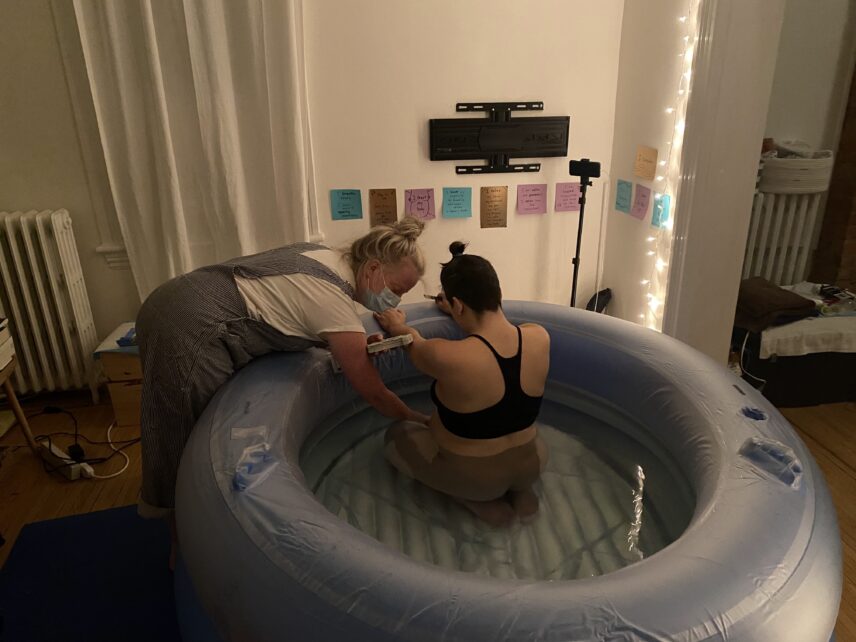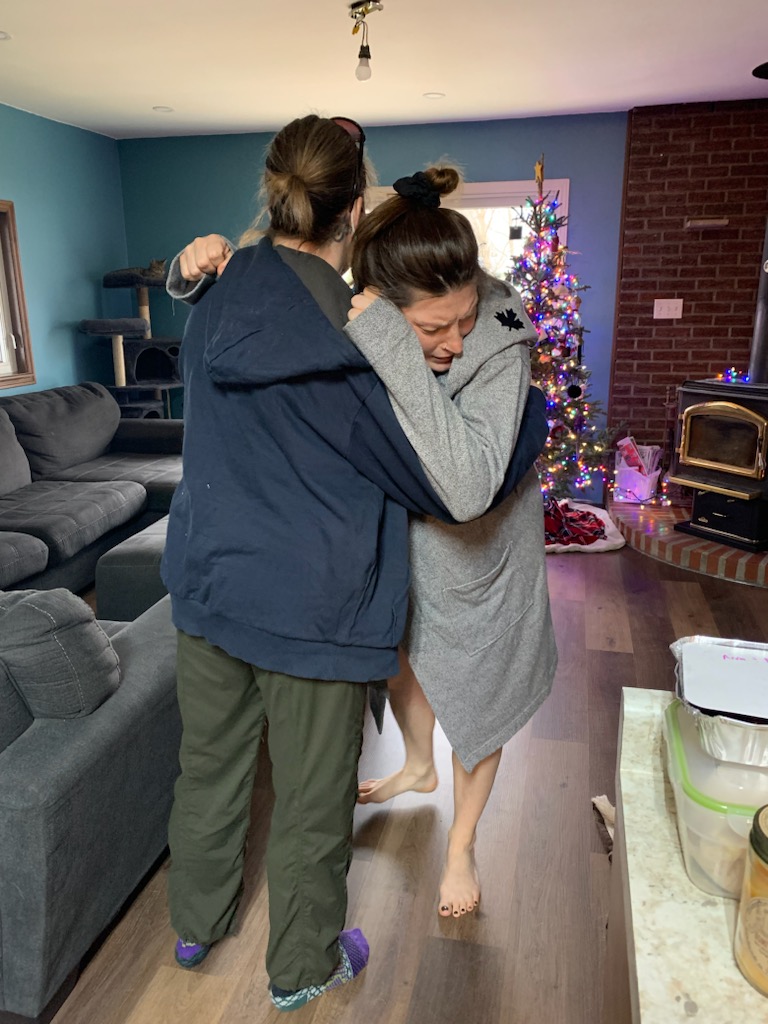Article begins
Throughout my career as a registered midwife, I’ve delivered hundreds of babies in hundreds of birthing rooms: hospital rooms; living rooms; kitchens; bedrooms; bathrooms a few times; a front hallway, twice; a staircase, once; a parking lot, almost once; an elevator. Birthing rooms, no matter the location, are places of labor—and where there is labor, there is heat. The heat of the birthing room is the heat of bodies in close proximity, of physical exertion, and of emotional intensity. It is heavy breathing, shallow breathing. It is deep moans, high cries. It is clutching hands, massage, draped bodies, bellies and breasts, fluid and blood, pacing, crying, slow dancing, showers, baths, teas, and towels. It is “No, keep going,” “Yes, keep going,” “You’re right there,” and “Don’t let go.” It is pushing, pushing, pushing. Birthing rooms are hot and uncomfortable places, for the hot and uncomfortable work of birthing a baby. I can’t think of a birth I didn’t leave sweat-dampened, grateful for the window down in the car on the way home.
Cool Cloth
Leila’s bedroom is a 6 ft x 8 ft rectangle; the double bed occupies almost two-thirds of the space, to the point that when the door opens, it bumps into the footboard. Once we are all in, inches from each other, the door remains closed, because Leila is worried that her toddler will wake before the new baby is born. Leila is lying on her side on the bed. Her partner, Juan, is behind her, kissing her shoulder between labor pains. She is only wearing a T-shirt, while he is only wearing shorts, as if they are sharing one outfit in solidarity. I can fit in the space between the bed and the wall, kneeling, the side of the mattress pressing into my chest as I lean toward Leila. My student midwife, Ada, perches at the foot of the bed, by the door. Heat radiates from the bed—Leila’s intense laboring, and the sweet romance of her husband’s support.
Of course, heat radiates from our bodies, too, just by being in the space. There is nowhere for the heat to go, so it sits between us and envelops us. Sweat shimmers on Leila’s forehead and thighs, on Juan’s chest. My T-shirt is glued to my skin. Ada struggles to don sterile gloves over slick hands. There is a basin of water and one cloth in it. If the water was cold when it was drawn from the tap and carried in, before the door was closed, now it’s rapidly absorbing the heat of the room.
While Leila wants this close space and the quietness it provides for her sleeping child, she does not feel comfortable in it. She writhes in pain; she cries out sotto voce into her pillow; she motions that she feels she will throw up. She needs a little relief. I press the wet cloth to her forehead, offering what little cool is available. In mere moments, I feel the heat of her skin absorbed into the damp cotton. I remove the cloth so I can spin it through the air, movement allowing some dissipation of heat; I’m conjuring cool. We get a rhythm going: cloth to forehead, relaxation; cloth removed to spin, tension; reapplication of the cloth, relaxation again. In the heat of this tiny room, I do what I can, what I know to do. I am also not comfortable in this room. What relief can be sourced is for Leila, not for me.
What is operating here, during this over-warm encounter? While it is a moment for care provision of the ameliorative kind, McKearney cautions against the presumption of claiming care as good or appropriate in the absence of a deep exploration of the recipient’s perception. I’m hesitant to say that the discomfort of the birthing room allows any opportunity to showcase techniques of care excellence. In fact, discomfort in the birthing room can be a space for refusal of care.

Just Stop
The great thing about Beth’s particular hospital is that there is a full bathroom in each labor room, and each bathroom has a full-sized bathtub. The bathroom can become space for cocooning—cordoning off from machines whirring and beeping, fluorescent lights, paperwork, and hallway banter. The bathtub can be filled with steaming water. Immersion in the hot water, in a dark and quiet room, can create a double cocoon. A cocoon is a necessary feature of what midwives call “the zone,” a sort of hypnotic state where the laboring person is fully concentrating on their experience of labor, riding the waves of contraction pains, often with eyes closed, making little noise beyond moans and breath sounds. It is similar to the trance-like state achieved during long-distance running, when an athlete gives in to the visceral experience, allowing the body to do what it needs to do.
Beth, in the hospital-room bathroom, in the tub of hot water, is in the zone. It is dark, and I am crouched beside her. It is winter, and COVID-19 is prevalent, so, clad in both wool sweater and surgical mask, I’m finding it increasingly prickly and airless in the steamy room. Beth’s face scrunches with pain during the contractions. I can see, despite the dim, that she is in agony every few minutes. What can help, I think, is a cool cloth. I move to prepare this familiar therapy and Beth’s expressive eyebrows narrow. A slight shake of the head: No. No cloth. I resume the crouch. Ah, I know! What can help is movement of the water in her bath, pouring over her belly in a warm, languid stream. Beth frowns. No. No stream. Perhaps the gentlest motion of the water, the slightest ripple, to soothe tender hips and thighs? Beth raises one finger. No. No ripple. Stop. I’m hot and tired and, frankly, a bit disgruntled. I resume my crouch beside her tub.
Is it compassion I am enacting? Am I virtuously motivated to act upon recognition of suffering with the desire and ability to alleviate it? I feel motivated to act and to alleviate what I perceive as Beth’s suffering, but it is inaction that Beth wants. And the inaction demanded of me serves to increase my own discomfort. I am reminded that care might be less about what I do and more about something else. One study found that patients feel cared for when caregivers are “emotionally present, communicate effectively, enter into their experience, and display understanding and kindness.” I am emotionally present, yes—but for birth care especially, I think physical presence is also part of the recipe. And it is one thing to be physically present when one’s needs as a healthcare provider—and more specifically, as a person who is a healthcare provider—are addressed. But what if they are not? What if I am as sweaty and uncomfortable as my birthing patient?
(And then I ask myself, do I have to be hot and sweaty, uncomfortable? Is that part of the job? I think it is. It’s right in the name, mid wif: with woman. I have to be there, and to be there is to experience the full effect of my environment.)

On Fire
We closed the windows against the screaming, choosing privacy over breeze. The closed window does not stop the July midday sun. That was over an hour ago. The contractions are now about two minutes apart, along with the screaming that accompanies each one and the double-hip-squeeze technique demanded of me as each surge of pain threatens to disintegrate Sam’s tailbone. “My back is on fire!” she exclaims when catching her breath, between waves. I can feel sweat trickle down my own tailbone. The repeated maximum isometric effort is getting to me; my hands losing their grip on Sam’s slippery skin. My arms, too, are on fire.
Humans evolved to find connection with other humans and to create spaces that facilitate and sustain that connection through intentional togetherness. On a basic level, being physically present in a care encounter forms a connectedness that can be perceived as care itself. Shared affectivity during a shared experience can also increase the perceived bond. You’re on fire; I’m on fire. We did this thing together. We had a meaningful experience.
If the heat of a birthing room is uncomfortable and can make being physically or emotionally present difficult as my own body responds to the environment, being hot and sweaty alongside a birthing person also leverages that shared experience as a form of care. Whether what’s needed is ameliorative therapy or the absence of therapy, some connection, meaningful connection, happens in a deeply human way through the shared discomfort.
A refusal to release myself from the discomfort—a commitment to remaining present—also allows my own vulnerability to blur the traditional line between care provider and patient. Often, that line suggests a power differential: the care provider is in charge, wielding special knowledge to which the patient is not privy, performing acts for which the patient should be grateful. Instead, vulnerability chips away at that paternalistic, patriarchal division and detachment, replacing it with relationality. My willingness to be affected and transformed by that relationality reflects Richa Nagar’s radical vulnerability, Rachelle Chadwick’s “sticky praxis.” According to Nagar, “entering solidarity and working through discomfort can reinvent and endure the inherent power imbalances between” the care provider and the patient. And Chadwick teaches that admitting there is something important happening in the messiness of discomfort, where it hurts, rejects the notion that birth care operates outside of the participation in the birth care, the being there.
When I explore the potential effects birth spaces offer to me, my first instinct is that allowing, acknowledging, or accepting the importance of my physical presence is one thing—but transformation? To what? Of what? And then I think: Ah! Perhaps the transformation is more like a journey, less like a destination. Being open to this progressive, transformative vulnerability requires deliberately seeing the forces acting in the space between care provider and care recipient—forces that connect and resist, the clean threads and snarled ones interwoven, the sticky and slippery contacts. What the heat of birthing rooms has clarified for me is that birth is a process of surrendering, of letting go—for both me and the laboring person. When I strive not only to see but to internalize this entanglement; when I do the work of reaching into the uncomfortable spaces not just in the room, but in myself; when I do the work I ask of laboring people, I participate in the making of a new world—one in which I’ve deconstructed the idea that I know best and instead forged in fire the fact that my solutions are my patient’s solutions.

